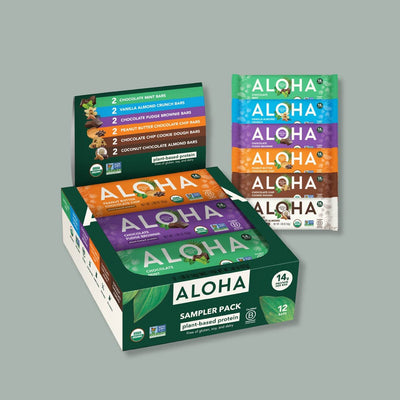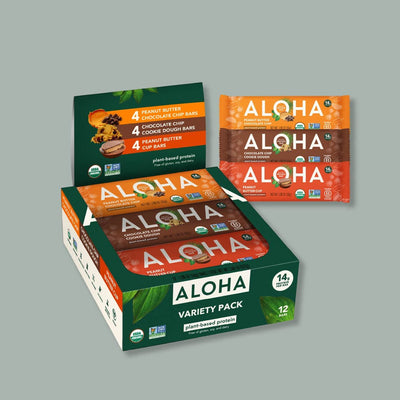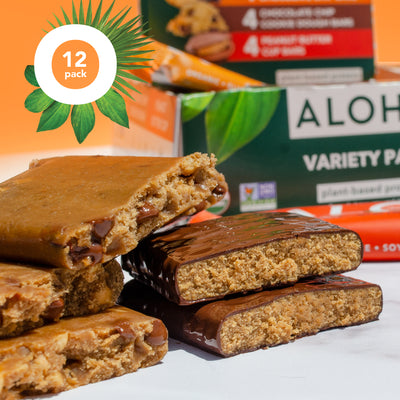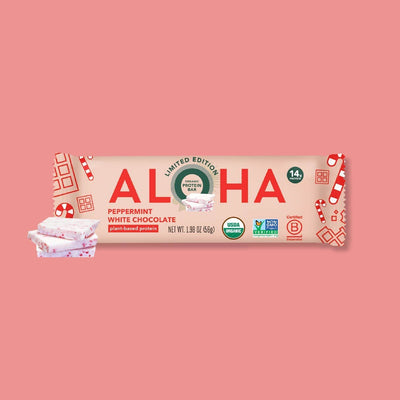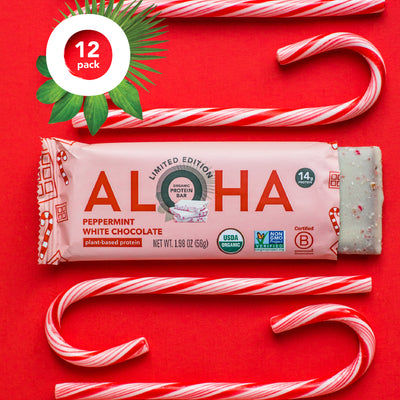Key Takeaways:
- Whole Food Sources Are Key: Healthy fats are best when they come from whole, recognizable ingredients like nuts, seeds, and avocados. These are easy to include in daily meals and snacks.
- Labels Tell the Story: Reading the nutrition label and ingredient list helps you identify the type and quality of fat in your food. Look for natural sources and skip the marketing hype.
- A Balanced Plant-Based Diet Includes Fats: Fats are essential to a thoughtful, plant-based lifestyle. When chosen carefully, they add flavor, texture, and satisfaction without complicating your diet.
Is fat really the enemy, or have we misunderstood it all along? For years, fat has been labeled as something to avoid — but that conversation is shifting. Like choosing quality ingredients in a recipe, selecting the right types of fats is less about restriction and more about intention.
At ALOHA, we’re redefining mindful snacking. As a Certified B Corporation focused on plant-based living, we craft organic, non-GMO snacks using simple, whole-food ingredients. From the source to the final bar, we keep it real—no shortcuts, no compromises. It’s nutrition you can trust from a brand that lives and breathes clean-label transparency.
In this piece, we’ll explore healthy fats, why they matter in a balanced plant-based lifestyle, and how to make thoughtful choices without overcomplicating what’s on your plate.
Why Your Body Needs Healthy Fats
Healthy fats may not get the same spotlight as protein or fiber, but they quietly play an important role in everyday wellness. They help your body absorb nutrients from food and support natural processes that keep things running smoothly, from your skin to your brain.
When choosing meals or snacks, including sources of healthy fats can add more than just flavor. They help round out a meal and bring a sense of satisfaction beyond the first bite. For those who follow plant-based or organic lifestyles, incorporating these fats is a simple way to stay connected to whole, nourishing ingredients.
Choosing healthy fats isn’t about trends — it’s about balance, simplicity, and making room for the right things on your plate.
Types Of Healthy Fats
When it comes to understanding what healthy fats are, it's helpful to break them down into categories. Each type uniquely influences how food supports your body, especially when it’s part of a plant-based approach. Here’s a look at the most common types of healthy fats and where they come from:
Monounsaturated Fats
Monounsaturated fats are known for their simplicity — they typically come from everyday ingredients like avocados, almonds, cashews, and olives. These fats are common in cooking oils such as olive oil or avocado oil, making them easy to include in meals without extra effort. Their natural, smooth texture adds richness to dressings, dips, or energy bars made from whole food ingredients.
Polyunsaturated Fats
This group includes essential fatty acids like omega-3 and omega-6, which must come from food since the body doesn’t produce them on its own. Polyunsaturated fats, found in sources like flaxseeds, chia seeds, sunflower seeds, and walnuts, are an important part of many plant-based eating patterns. They tend to show up in nutrient-dense snacks and pantry staples that add flavor and balance to a meal.
Natural Fats From Whole Foods
These fats are packaged in whole, recognizable ingredients—think nut butters, seeds, and coconut. Because they haven’t been overly processed, they bring more to the table than just fat: texture, fiber, and a sense of satisfaction. They’re also incredibly versatile, appearing in bars, smoothies, bowls, and even simple snacks made with clean, intentional ingredients.
Sources Of Healthy Fats In A Plant-Based Diet
For those following a plant-based lifestyle, healthy fats aren’t hard to find — they’re made up of many ingredients that are already pantry staples. These sources are rich in natural fats and align with organic, non-GMO, and minimally processed values. If you’re wondering where to begin, start with these familiar, whole food options:
- Nuts and Nut Butters: Almonds, cashews, walnuts, and peanuts are classic sources of healthy fats. Whether raw, roasted, or blended into smooth butters, they offer a naturally satisfying way to add richness to snacks or meals. When choosing nut butters, look for options that skip added sugars and preservatives for a more authentic, plant-forward ingredient.
- Seeds and Seed-Based Ingredients: Seeds like flax, chia, pumpkin, and sunflower are small but mighty when it comes to healthy fat content. They’re often included in bars, smoothies, and baking mixes, offering texture and nutrition in every bite. You’ll also find seed oils or seed butters that keep things simple and nourishing.
- Avocados: Avocados are a staple in plant-based eating for a reason. They’re rich in monounsaturated fats and have a creamy texture that works well in everything from toast toppings to smoothie bases. With minimal prep and maximum versatility, avocados fit naturally into any thoughtful eating routine.
- Plant Oils: Oils pressed from olives, avocados, flaxseeds, or sunflower seeds are everyday sources of fat that carry both flavor and function. A drizzle can enhance roasted veggies, salad dressings, or grain bowls without overpowering the rest of the dish. When choosing oils, choose those labeled cold-pressed or minimally refined for a more intentional choice.
How To Include Healthy Fats In Your Daily Meals
Incorporating healthy fats doesn’t have to mean changing your entire eating routine. It’s often as simple as making small swaps or additions that elevate flavor and satisfaction without complicating your meals. Here are some easy, approachable ways to include healthy fats in your day-to-day choices:
Add Nuts Or Seeds To Meals
A sprinkle of chopped almonds, chia seeds, or pumpkin seeds can add a satisfying crunch to oatmeal, salads, or smoothie bowls. These ingredients bring texture and a dose of natural fats without much prep. They’re also easy to pack into on-the-go snacks or lunch boxes.
Use Avocado As A Spread Or Ingredient
Instead of using processed spreads, avocado can be mashed onto toast, folded into wraps, or blended into sauces. Its naturally creamy texture makes it a flexible ingredient in savory and sweet dishes. Plus, it pairs well with a wide variety of plant-based flavors.
Choose Snacks Made With Whole Food Fats
Look for bars or bites that use ingredients like nut butters, coconut, or seed blends. These snacks often deliver healthy fats in a convenient and satisfying way. Keep an eye on labels to ensure you choose options with clean, simple ingredients and no unnecessary fillers.
Cook With Plant-Based Oils
Olive oil, avocado oil, or sunflower oil are great choices for sautéing, roasting, or finishing dishes. These oils complement vegetables, grains, and proteins without masking their natural flavors. A light drizzle after cooking can also bring out richness without additional sauces or toppings.
How To Read Nutrition Labels For Healthy Fats
Understanding food labels can help you make more intentional choices without overthinking it. While the ingredient list gives you the “what,” the nutrition label gives you the “how much,” and knowing what to look for can make all the difference. Here’s how to quickly spot healthy fats when scanning a label:
Check The Type Of Fat Listed
Not all fats are created equal, and labels typically break them down into saturated fat, trans fat, and unsaturated fat. While the total fat number gives you a big-picture view, the real story is in the breakdown. Prioritize foods that highlight monounsaturated and polyunsaturated fats, and steer clear of anything with trans fats.
Look At The Ingredient List
A short, recognizable ingredient list is often a sign of a cleaner product. Ingredients like almonds, flaxseed, or sunflower butter signal natural fat sources. If the list includes hydrogenated oils or unfamiliar additives, it might be a sign to put it back on the shelf.
Pay Attention To Serving Size
Healthy fats are naturally more calorie-dense, so serving sizes can be smaller than expected. Reading the label carefully helps you understand how much you’re eating, especially with snacks or packaged foods. This keeps things balanced and intentional without tracking or measuring every bite.
Watch For Marketing Buzzwords
Labels can sometimes use words like “light,” “low-fat,” or “fat-free” to make a product sound healthier than it is. These terms don’t always mean better; sometimes, removing fat means adding extra sugar or fillers for taste. Focus less on the marketing claims and more on ingredients and fat sources.
Final Thoughts
Understanding what healthy fats are is less about following the latest food trend and more about reclaiming a balanced, intentional approach to eating. These fats aren’t just nutrients—they’re an invitation to nourish your body with care and clarity. Choosing high-quality, plant-based fat sources is a simple yet powerful way to support overall wellness without complicating your lifestyle. In a world of quick fixes and confusing labels, healthy fats remind us to slow down, read the ingredients, and make choices that feel good both now and in the long run.
Read also:
- How Long Does Protein Stay In Your System? Key Facts
- How Many Calories Are In A Protein Shake? Calorie Guide
- Benefits Of Superfoods: Why They Boost Your Health
Frequently Asked Questions About Healthy Fats
Can healthy fats go bad or spoil?
Healthy fats—especially those from nuts, seeds, and oils—can become rancid over time if not stored properly. Exposure to light, heat, or air can accelerate spoilage. Always check expiration dates and store oils and fats in cool, dark places.
Are all plant-based oils considered healthy fats?
Not all plant-based oils are equal in quality or nutrition. While some, like olive or flaxseed oil, are considered healthy, others can be overly refined or stripped of nutrients. Look for cold-pressed, unrefined oils when possible.
Do healthy fats have a taste?
Yes, many healthy fats have distinct natural flavors. For example, olive oil has a peppery richness, and nut butters carry a roasted, creamy profile. These flavors can enhance the taste of your meals without added seasonings.
Is it okay to eat healthy fats every day?
Healthy fats can be part of a daily eating pattern in moderation. Whole food sources like nuts, seeds, and avocados offer a balanced way to enjoy them regularly. The key is to avoid overloading on processed fats or eating them in excess.
What’s the difference between saturated and unsaturated fats?
Saturated fats are typically solid at room temperature and are often found in animal products or heavily processed foods. Unsaturated fats, found in plants, are usually liquid and considered more balanced for everyday meals. It's not about cutting out fat, but choosing the type that aligns with a natural eating style.
Can kids eat foods with healthy fats?
Yes, kids can benefit from healthy fats as part of a balanced diet. Foods like nut butters, avocado, and seeds offer energy and satisfaction in child-friendly portions. Always be mindful of allergies or choking risks with whole nuts or seeds.
How do I know if a snack contains healthy fats?
Check the ingredient list for nuts, seeds, avocados, or natural oils. If the source of fat comes from whole foods, it’s usually a better option. Avoid snacks with hydrogenated oils or long, complex ingredient lists.
Can I cook with healthy fats at high heat?
Some healthy fats handle heat better than others. For example, avocado oil and refined olive oil have higher smoke points and are suitable for roasting or sautéing. More delicate oils, like flaxseed oil, are better for cold uses, such as dressings.
Are coconut products considered a healthy fat?
Coconut contains saturated fats, which makes its classification a bit debated. While it's plant-based and often used in clean-label products, it’s best to enjoy coconut in moderation. Look for minimally processed versions like shredded coconut or coconut milk without additives.
Can I get enough healthy fats from snacks alone?
Snacks can help, but combining them with meals is best for balance. Whole food snacks with nuts, seeds, or plant-based oils boost healthy fat throughout the day. But a mix of meals and snacks is the most natural approach.
Sources:
1. Hewlings, S. (2020). Coconuts and Health: Different Chain Lengths of Saturated Fats Require Different Consideration. Journal of Cardiovascular Development and Disease, 7(4), 59. https://doi.org/10.3390/jcdd7040059
2. Vieira, S. A., McClements, D. J., & Decker, E. A. (2015). Challenges of utilizing healthy fats in foods123. Advances in Nutrition, 6(3), 309–317. https://doi.org/10.3945/an.114.006965
3. Liu, A. G., Ford, N. A., Hu, F. B., Zelman, K. M., Mozaffarian, D., & Kris-Etherton, P. M. (2017). A Healthy Approach to Dietary fats: Understanding the Science and Taking Action to Reduce Consumer Confusion. Nutrition Journal, 16(1). https://doi.org/10.1186/s12937-017-0271-4
4. Lee, Y. R. (2015). Choosing Healthy Fats. The Journal of Korean Diabetes, 16(3), 205. https://doi.org/10.4093/jkd.2015.16.3.205
ALOHA's products are not intended to treat, diagnose, mitigate, prevent, or cure disease. ALOHA's products should not replace prescribed medications or the variety of foods important to a healthful diet.
Do not self-diagnose any health condition. Work with your healthcare provider to determine how best to achieve optimal health.





